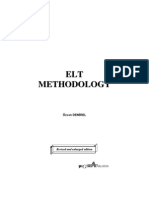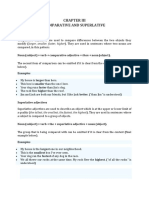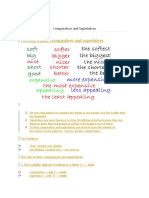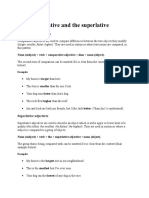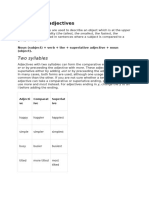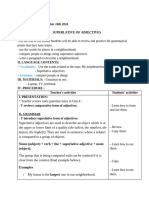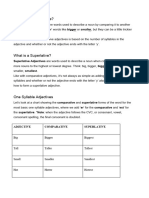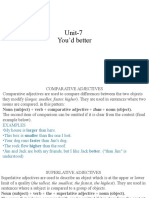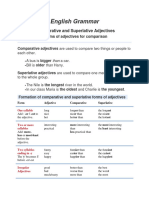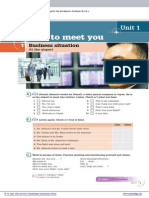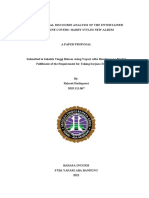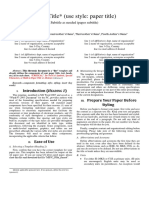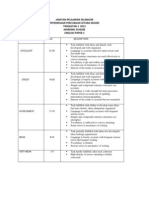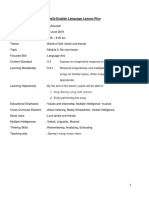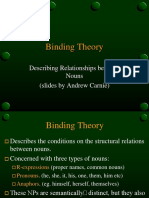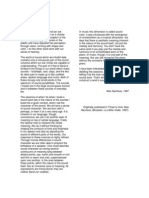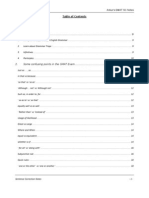Comparative
Comparative
Uploaded by
Sonia PerezCopyright:
Available Formats
Comparative
Comparative
Uploaded by
Sonia PerezOriginal Description:
Original Title
Copyright
Available Formats
Share this document
Did you find this document useful?
Is this content inappropriate?
Copyright:
Available Formats
Comparative
Comparative
Uploaded by
Sonia PerezCopyright:
Available Formats
The comparative and the superlative
Comparative adjectives
Comparative adjectives are used to compare differences between the two objects they
modify (larger, smaller, faster, higher). They are used in sentences where two nouns are
compared, in this pattern:
Noun (subject) + verb + comparative adjective + than + noun (object).
The second item of comparison can be omitted if it is clear from the context (final example
below).
Examples
My house is larger than hers.
This box is smaller than the one I lost.
Your dog runs faster than Jim's dog.
The rock flew higher than the roof.
Jim and Jack are both my friends, but I like Jack better. ("than Jim" is understood)
Superlative adjectives
Superlative adjectives are used to describe an object which is at the upper or lower limit of
a quality (the tallest, the smallest, the fastest, the highest). They are used in sentences
where a subject is compared to a group of objects.
Noun (subject) + verb + the + superlative adjective + noun (object).
The group that is being compared with can be omitted if it is clear from the context (final
example below).
Examples
My house is the largest one in our neighborhood.
This is the smallest box I've ever seen.
Your dog ran the fastest of any dog in the race.
We all threw our rocks at the same time. My rock flew the highest. ("of all the
rocks" is understood)
Forming regular comparatives and superlatives
Forming comparatives and superlatives is easy. The form depends on the number of
syllables in the original adjective.
One syllable adjectives
Add -er for the comparative and -est for the superlative. If the adjective has a consonant +
single vowel + consonant spelling, the final consonant must be doubled before adding the
ending.
Adjective Comparative Superlative
tall taller tallest
fat fatter fattest
big bigger biggest
sad sadder saddest
Two syllables
Adjectives with two syllables can form the comparative either by adding -er or by
preceeding the adjective with more. These adjectives form the superlative either by adding
-est or by preceeding the adjective with most. In many cases, both forms are used,
although one usage will be more common than the other. If you are not sure whether a
two-syllable adjective can take a comparative or superlative ending, play it safe and use
more and most instead. For adjectives ending in y, change the y to an i before adding the
ending.
Adjective Comparative Superlative
happy happier happiest
simple simpler simplest
busy busier busiest
tilted more tilted most tilted
tangled more tangled most tangled
Three or more syllables
Adjectives with three or more syllables form the comparative by putting more in front of the
adjective, and the superlative by putting most in front.
Adjective Comparative Superlative
important more important most important
expensive more expensive most expensive
Irregular comparatives and superlatives
These very common adjectives have completely irregular comparative and superlative
forms.
Adjective Comparative Superlative
good better best
bad worse worst
little less least
Adjective Comparative Superlative
much more most
far further / farther furthest / farthest
Examples
Today is the worst day I've had in a long time.
You play tennis better than I do.
This is the least expensive sweater in the store.
This sweater is less expensive than that one.
I ran pretty far yesterday, but I ran even farther today.
Comparativos de superioridad. En las comparaciones de superioridad, el adjetivo, que está en la
forma comparativa (véase más adelante), es seguido por “than”.
Forming Comparative and Superlatives of Irregular
Adjectives
It’s important to note that there are irregular adjectives (and adverbs) that you have to
memorize because they don’t follow the rules above. They are:
Adjective/Adverb Comparative Superlative
good/well better best
bad/badly worse worst
far farther, further the farthest, the furthest
little less least
Here are some examples of these irregular words as comparatives and superlatives in
context:
Today I had the best time touring the city.
I went farther than my friend when we walked around the park.
You dance better than I do.
You bought the least attractive pair of moccasins at the thrift store.
He can run the farthest of his classmates, but that’s only once around the track.
I do badly in math, but at least I’m not the worst .
Adjective/Adverb Comparative Superlative
good/well better best
bad/badly worse worst
far farther, further the farthest, the furthest
little less least
Here are some examples of these irregular words as comparatives and superlatives in
context:
Today I had the best time touring the city.
I went farther than my friend when we walked around the park.
You dance better than I do.
You bought the least attractive pair of moccasins at the thrift store.
He can run the farthest of his classmates, but that’s only once around the track.
I do badly in math, but at least I’m not the worst .
Los comparativos y superlativos en inglés son usados para describir dos o más
cosas. Los comparativos agregan la terminación "-er" a las palabras para
comparar dos cosas, conectados con "than" (que). Por ejemplo, "An elephant is
bigger than a mouse" (un elefante es más grande que un ratón). Los superlativos
comparan tres o más cosas, añadiendo la terminación "-est" a las palabras y
usando "the" (artículo), porque solo puede haber un superlativo. Por ejemplo, "She
was the smartest girl in the class" (Ella era la niña más inteligente de la clase).
Lección interactiva
Involucra a los estudiantes en la actividad, encontrando superlativos alrededor de la clase.
Utiliza una cinta de medir o pide a los estudiantes que se paren espalda con espalda y que la
clase diga qué estudiante es más alto y cuál es más bajo. Pide que encuentren a los alumnos
más altos y bajos en la clase. Pídeles también que digan qué estudiante tiene el cabello
oscuro o claro y cuál tiene el cabello más oscuro y más claro. Encuentra objetos en el salón
para poder compararlos. Pídeles que digan qué imagen está más alta y más baja en el salón.
Haz que señalen a quién tiene el escritorio más grande y quién el más pequeño.
You might also like
- GMAT® Official Guide Supplement: Sentence Correction BasicsFrom EverandGMAT® Official Guide Supplement: Sentence Correction BasicsRating: 4.5 out of 5 stars4.5/5 (5)
- ELT MethodologyDocument25 pagesELT Methodologydeana_jeeNo ratings yet
- Tense and Aspect in Bantu - Derek Nurse PDFDocument422 pagesTense and Aspect in Bantu - Derek Nurse PDFALBERT URRUTIA CASANOVA100% (1)
- The ComparativeDocument3 pagesThe Comparativeachmad.sae15No ratings yet
- Unit 3 The Comparative and The SuperlativeDocument6 pagesUnit 3 The Comparative and The SuperlativeSaroNo ratings yet
- Comparative Degree (Grammar of Spoken)Document3 pagesComparative Degree (Grammar of Spoken)risma filzahNo ratings yet
- Comparison of DegreeDocument6 pagesComparison of DegreerrimagangNo ratings yet
- Comparative and Superlative AdjectivesDocument14 pagesComparative and Superlative AdjectivesJams DjNo ratings yet
- Superlative Adjectives RulesDocument4 pagesSuperlative Adjectives RulesMara CisnerosNo ratings yet
- Comparative AdjectivesDocument8 pagesComparative AdjectivesDinar Nuraisyah GueltomzNo ratings yet
- Comparative and Superlative AdjectivesDocument5 pagesComparative and Superlative AdjectiveschristideiviNo ratings yet
- Meeting 5 Comparative and SuperlativeDocument5 pagesMeeting 5 Comparative and SuperlativedebeeNo ratings yet
- Comparative AdjectivesDocument3 pagesComparative AdjectivesYoo ChenchenNo ratings yet
- Comparatives and SuperlativesDocument11 pagesComparatives and SuperlativesRhonny JaimesNo ratings yet
- Comparative and Superlative (L)Document3 pagesComparative and Superlative (L)Jesús MarínNo ratings yet
- Comparative and Superlative AdjectivesDocument5 pagesComparative and Superlative Adjectiveseman abdelhaqNo ratings yet
- Part II Superlative AdjectivesDocument3 pagesPart II Superlative AdjectivessdevertelNo ratings yet
- The Comparative and The SuperlativeDocument3 pagesThe Comparative and The SuperlativeNurlailah SidiqNo ratings yet
- Unidad IV InglesDocument9 pagesUnidad IV InglesVenturo Asencio AnyeloNo ratings yet
- Comparative and Superlative AdjectivesDocument5 pagesComparative and Superlative AdjectivesrmaikessengNo ratings yet
- Comparative N Superlative AdjectivesDocument2 pagesComparative N Superlative AdjectivesTheivina Narayanasamy100% (1)
- Bab IDocument6 pagesBab ISylvia Nur ArwandaNo ratings yet
- Comparative AdjectivesDocument3 pagesComparative AdjectivesSaqlain Ishtiaq100% (1)
- Comparative and Superlative AdjectivesDocument4 pagesComparative and Superlative AdjectivesYosienta CahyandiniNo ratings yet
- Comparative AdjectivesDocument6 pagesComparative AdjectivesbalaNo ratings yet
- Comparative and Superlative AdjectivesDocument5 pagesComparative and Superlative AdjectivesYoussef BrsNo ratings yet
- Comparative and Superlative SentencesDocument3 pagesComparative and Superlative SentencesVaneshaNo ratings yet
- Diapositivas InglesDocument10 pagesDiapositivas InglesGenesis Gibelly QUINTERO MORALESNo ratings yet
- The Comparative and The SuperlativeDocument13 pagesThe Comparative and The SuperlativeGerardo Chahua100% (1)
- 3rd Lesson Comparative and Superlative AdjectivesDocument4 pages3rd Lesson Comparative and Superlative AdjectivessaliaNo ratings yet
- Text 2Document7 pagesText 2Daniela Ramos EduardoNo ratings yet
- Guia de Estudio InglesDocument13 pagesGuia de Estudio Inglesec018266No ratings yet
- Noun (Subject) + Verb + Comparative Adjective + Than + Noun (Object)Document50 pagesNoun (Subject) + Verb + Comparative Adjective + Than + Noun (Object)Eduardo Chávez DuránNo ratings yet
- Comparative and Superlative AdjectivesDocument4 pagesComparative and Superlative AdjectivesLi AlavNo ratings yet
- Comparative and The SuperlativeDocument5 pagesComparative and The SuperlativeJonathan ValenciaNo ratings yet
- Superlative AdjectivesDocument3 pagesSuperlative AdjectivessirineNo ratings yet
- 01 UNIT II - Comparatives and Superlative TheoryDocument5 pages01 UNIT II - Comparatives and Superlative TheoryFernando SalgadoNo ratings yet
- Comparative and Superlative AdjectiveDocument6 pagesComparative and Superlative AdjectiveOscar GuayanaNo ratings yet
- Comparative and Superlative AdjectivesDocument6 pagesComparative and Superlative AdjectivesAzazel wellsNo ratings yet
- Comperative Superlative - Comperative-SuperlativeDocument5 pagesComperative Superlative - Comperative-SuperlativeAna Paula De MarcoNo ratings yet
- Comparative and Superlative Adjectives: Noun (Subject) + Verb + Comparative Adjective + Than + Noun (Object)Document10 pagesComparative and Superlative Adjectives: Noun (Subject) + Verb + Comparative Adjective + Than + Noun (Object)sehamNo ratings yet
- Comparatives and SuperlativesDocument2 pagesComparatives and SuperlativesSantana Bazán Elim MicheletNo ratings yet
- Week: 11 Date of Teaching: November 16th 2024: + Vocabulary: - + GrammarDocument14 pagesWeek: 11 Date of Teaching: November 16th 2024: + Vocabulary: - + GrammarThắm GiảnNo ratings yet
- Tarea de English 2Document15 pagesTarea de English 2Wîndêl Kìng Sânchèz100% (1)
- Lesson 15: Costache Reli-CătălinaDocument27 pagesLesson 15: Costache Reli-CătălinaMiha MihaelaNo ratings yet
- The Comparative and The SuperlativeDocument5 pagesThe Comparative and The SuperlativeGabyMatarNo ratings yet
- English Notes Third Term 2021.Document5 pagesEnglish Notes Third Term 2021.Luisa RodriguesNo ratings yet
- Degrees of AdjectivesDocument3 pagesDegrees of AdjectivesScarlet RedNo ratings yet
- ComparativesDocument9 pagesComparativesPettNo ratings yet
- Dr. Eng Jordão Ortega Jemusse ManguenaDocument11 pagesDr. Eng Jordão Ortega Jemusse ManguenajemusseNo ratings yet
- Comparative: A Comparative Is The Form of Adjective or Adverb Used To Compare Two Things. A Comparative Is Known As TheDocument6 pagesComparative: A Comparative Is The Form of Adjective or Adverb Used To Compare Two Things. A Comparative Is Known As TheJamie Tan Ling SanNo ratings yet
- Comparison: Adverbs (Worse, More Easily) : Adverbs: Comparative and Superlative FormsDocument9 pagesComparison: Adverbs (Worse, More Easily) : Adverbs: Comparative and Superlative FormsFABIAN FIENGONo ratings yet
- LK. Degree of ComparisonDocument5 pagesLK. Degree of ComparisonNandita OliviaNo ratings yet
- مستند PDFق،Document5 pagesمستند PDFق،adysat77No ratings yet
- Comparatives and SuperlativesDocument15 pagesComparatives and SuperlativesMaría del Rosario AlonsoNo ratings yet
- Unit-7 You'd BetterDocument13 pagesUnit-7 You'd BetterЧулуунбаатар БаасанжаргалNo ratings yet
- Functions of Adjectives: ExamplesDocument9 pagesFunctions of Adjectives: ExamplesDwi WulandariNo ratings yet
- English Grammar - ComparativesDocument8 pagesEnglish Grammar - Comparativesblackmagic.2xNo ratings yet
- Articles & Proper AdjectivesDocument2 pagesArticles & Proper AdjectivesSagar KhanNo ratings yet
- Ingles Unidad 2Document20 pagesIngles Unidad 2Deiissy ChagalaNo ratings yet
- Artikel Bahasa Inggris LelyDocument11 pagesArtikel Bahasa Inggris LelyNurmahalina Triani PNo ratings yet
- ComparativesnandnSuperlativesnLeveln2 34607f0d1f0a9d6Document4 pagesComparativesnandnSuperlativesnLeveln2 34607f0d1f0a9d6Luisa DíazNo ratings yet
- English BusinessDocument10 pagesEnglish Businessreddragon1031100% (1)
- Multimodal Discourse Analysis Rahasti HerliapsariDocument18 pagesMultimodal Discourse Analysis Rahasti HerliapsariRahasti HerliapsariNo ratings yet
- 1 - Basic 2-SEA Basic II - IDocument5 pages1 - Basic 2-SEA Basic II - IFasya Neza Zainal AbidinNo ratings yet
- Paper Title (Use Style: Paper Title) : Subtitle As Needed (Paper Subtitle)Document4 pagesPaper Title (Use Style: Paper Title) : Subtitle As Needed (Paper Subtitle)adriana farnizaNo ratings yet
- Cambridge Primary Maths Curriculum OutlineDocument2 pagesCambridge Primary Maths Curriculum OutlineMike Serge Razafi0% (1)
- A - Add Capital Letters and Punctuation To The SentencesDocument2 pagesA - Add Capital Letters and Punctuation To The SentencesShosho AlmaeNo ratings yet
- Skema Pemarkahan Pppa Bi PMR k2Document4 pagesSkema Pemarkahan Pppa Bi PMR k2ŠtêaĹeř RaøNo ratings yet
- Sight Translation Hoang Thanh An - QHF1.2007Document77 pagesSight Translation Hoang Thanh An - QHF1.2007Nương ĐoànNo ratings yet
- Unit Plan - La FamiliaDocument4 pagesUnit Plan - La Familiaapi-2222845310% (1)
- Daily English Language Lesson PlanDocument4 pagesDaily English Language Lesson PlanAina NadhirahNo ratings yet
- Project Based Learning Daily Proverbs & IdiomsDocument64 pagesProject Based Learning Daily Proverbs & Idiomsnor idayu idrusNo ratings yet
- Scancleft Speech Assessment PDFDocument16 pagesScancleft Speech Assessment PDFMersal LogeshNo ratings yet
- Micro Teach Lesson Plan Final MataDocument3 pagesMicro Teach Lesson Plan Final Mataapi-301877190No ratings yet
- The Surprisingly Simple Logic Behind Japanese Sentence Structure - 80 - 20 JapaneseDocument29 pagesThe Surprisingly Simple Logic Behind Japanese Sentence Structure - 80 - 20 JapaneseSky StarNo ratings yet
- Introduction To Linguistic AnthropologyDocument7 pagesIntroduction To Linguistic Anthropologymalfet1066No ratings yet
- 1ºbach Unit2 Past PerfectDocument3 pages1ºbach Unit2 Past PerfectyaizaNo ratings yet
- Grammar 1Document22 pagesGrammar 1HoJoJoNo ratings yet
- Binding Theory: Describing Relationships Between Nouns (Slides by Andrew Carnie)Document26 pagesBinding Theory: Describing Relationships Between Nouns (Slides by Andrew Carnie)Alaa YasinNo ratings yet
- English OrthographyDocument22 pagesEnglish OrthographyTrajano1234100% (1)
- Sound As A MediumDocument1 pageSound As A MediumPhilippe F. RouxNo ratings yet
- Chapter 1 PDFDocument4 pagesChapter 1 PDFZakiah KhyNo ratings yet
- Exercisies in Word Prefix Suffix Root CombinationDocument8 pagesExercisies in Word Prefix Suffix Root CombinationN KNo ratings yet
- Ankur SCDocument135 pagesAnkur SCAditya KrishnaNo ratings yet
- Study Skills Unit2Document7 pagesStudy Skills Unit2api-259860195No ratings yet
- Bagaimana Mengaplikasikan Amalan Perkhidmatan Kaunter TerbaikDocument35 pagesBagaimana Mengaplikasikan Amalan Perkhidmatan Kaunter Terbaiksszma100% (4)
- Unit 5 The Perfect TenseDocument6 pagesUnit 5 The Perfect TenseJorge LunaNo ratings yet
- The History of The English Language Factfile Stage 4 ActivitiesDocument3 pagesThe History of The English Language Factfile Stage 4 ActivitiesAvlande50% (2)
- Introduction To MorphologyDocument17 pagesIntroduction To MorphologyDiba BasarNo ratings yet

